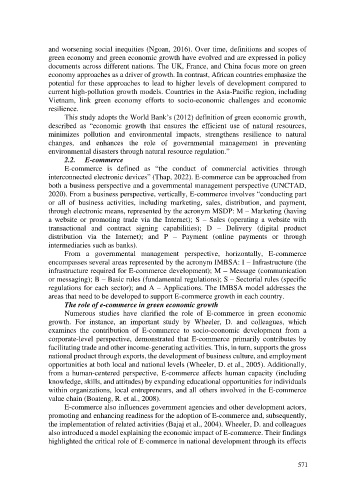Page 579 - Ebook HTKH 2024
P. 579
and worsening social inequities (Ngoan, 2016). Over time, definitions and scopes of
green economy and green economic growth have evolved and are expressed in policy
documents across different nations. The UK, France, and China focus more on green
economy approaches as a driver of growth. In contrast, African countries emphasize the
potential for these approaches to lead to higher levels of development compared to
current high-pollution growth models. Countries in the Asia-Pacific region, including
Vietnam, link green economy efforts to socio-economic challenges and economic
resilience.
This study adopts the World Bank’s (2012) definition of green economic growth,
described as “economic growth that ensures the efficient use of natural resources,
minimizes pollution and environmental impacts, strengthens resilience to natural
changes, and enhances the role of governmental management in preventing
environmental disasters through natural resource regulation.”
2.2. E-commerce
E-commerce is defined as “the conduct of commercial activities through
interconnected electronic devices” (Thap, 2022). E-commerce can be approached from
both a business perspective and a governmental management perspective (UNCTAD,
2020). From a business perspective, vertically, E-commerce involves “conducting part
or all of business activities, including marketing, sales, distribution, and payment,
through electronic means, represented by the acronym MSDP: M – Marketing (having
a website or promoting trade via the Internet); S – Sales (operating a website with
transactional and contract signing capabilities); D – Delivery (digital product
distribution via the Internet); and P – Payment (online payments or through
intermediaries such as banks).
From a governmental management perspective, horizontally, E-commerce
encompasses several areas represented by the acronym IMBSA: I – Infrastructure (the
infrastructure required for E-commerce development); M – Message (communication
or messaging); B – Basic rules (fundamental regulations); S – Sectorial rules (specific
regulations for each sector); and A – Applications. The IMBSA model addresses the
areas that need to be developed to support E-commerce growth in each country.
The role of e-commerce in green economic growth
Numerous studies have clarified the role of E-commerce in green economic
growth. For instance, an important study by Wheeler, D. and colleagues, which
examines the contribution of E-commerce to socio-economic development from a
corporate-level perspective, demonstrated that E-commerce primarily contributes by
facilitating trade and other income-generating activities. This, in turn, supports the gross
national product through exports, the development of business culture, and employment
opportunities at both local and national levels (Wheeler, D. et al., 2005). Additionally,
from a human-centered perspective, E-commerce affects human capacity (including
knowledge, skills, and attitudes) by expanding educational opportunities for individuals
within organizations, local entrepreneurs, and all others involved in the E-commerce
value chain (Boateng, R. et al., 2008).
E-commerce also influences government agencies and other development actors,
promoting and enhancing readiness for the adoption of E-commerce and, subsequently,
the implementation of related activities (Bajaj et al., 2004). Wheeler, D. and colleagues
also introduced a model explaining the economic impact of E-commerce. Their findings
highlighted the critical role of E-commerce in national development through its effects
571

